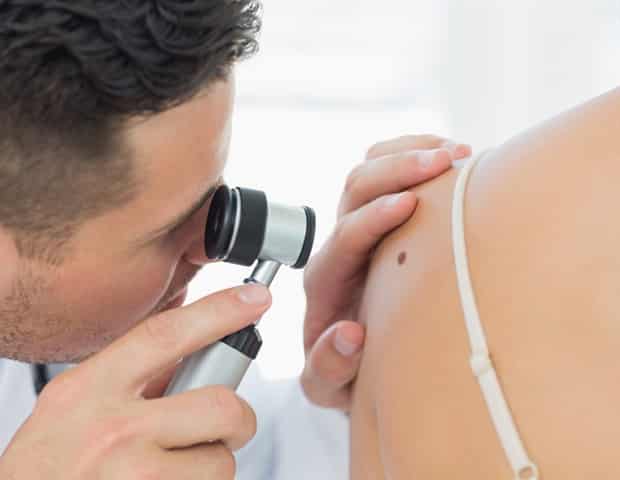Actinic keratosis is a precancer of the skin caused by frequent and prolonged sun exposure. It appears as flat or raised bumps or rough patches on the skin and is also commonly referred to as solar keratosis. Actinic keratosis develops slowly over years of exposure to high UV rays and tends to occur on areas likely to be exposed to the sun, namely the face, lips, ears, scalp, shoulders, neck, and forearms. Actinic keratosis can be hard to detect, as the rough patches are generally small and may look like dry skin. Since it takes so long to develop, actinic keratosis is usually only visible in people over 40. The lesions are innocuous for the most part but can morph into skin cancer on rare occasions. Reducing sun exposure and regularly using a high SPF sunscreen can help reduce the risk of actinic keratosis. Avoid tanning beds, as they are key contributors to actinic keratosis as well as participating in actinic keratosis treatment early when it’s first noticed.
Signs and Symptoms
Signs and symptoms of actinic keratosis include:
- Patches of rough, dry, or scaly skin measuring less than one inch in diameter
- Flat or raised bumps on the skin
- Hard, wart-like bumps
- Red, pink, or brown patches on the skin
- Inflamed skin and itching or burning in the affected area
Actinic keratosis presents itself in varied colors and shapes. As it can be difficult to detect, you should seek medical advice if you suspect you have actinic keratosis.
Risks and Complications
Actinic keratosis is not limited to but is more likely to occur in people who:
- Are over 40 years of age
- Live in a warm place with high sun exposure
- Have repeatedly experienced severe sunburn
- Have red or light-colored hair and light-colored eyes
- Develop freckles after sun exposure
- Have a family history of actinic keratosis or skin cancer
- Have been treated with chemotherapy or other treatments for leukemia or AIDS, resulting in a weakened immune system
When caught early, actinic keratosis poses a low risk for developing into skin cancer. If left untreated, actinic keratosis can morph into squamous cell carcinoma. However, squamous cell carcinoma is generally not life-threatening if caught and treated early enough.
Diagnosis
If you suspect you have actinic keratosis, consult your doctor. They will likely be able to confirm or deny your suspicions just by looking at your skin. In some cases, your doctor may run other tests such as a skin biopsy. Biopsies can be performed within the doctor’s office under local anesthetic. During a biopsy, your doctor will remove a small layer of skin for lab examination to determine whether actinic keratosis is present.
Treatments
Although actinic keratosis can disappear on its own, it is best not to leave it untreated as the condition can return after new sun exposure. Not all actinic keratosis poses a risk for skin cancer, but all lesions and patches of actinic keratosis should be removed as a precaution. Depending on the nature of your actinic keratosis, your doctor will recommend one of several treatments.
Cryotherapy
Cryotherapy is the most widely-used treatment for actinic keratosis. During a cryotherapy procedure, your doctor will remove the skin lesion with a freezing agent, usually liquid nitrogen. After the freezing agent is applied, skin in the affected area will start to peel and blister, causing the lesions to essentially die and fall off.
The process only takes a few minutes and can be done in the doctor’s office. Side effects of cryotherapy include:
- Blisters
- Scarring
- Altered skin texture
- Darkening of the skin in the treated area
- Infection
Topical Prescription Therapy
If your Actinic Keratosis is widespread or occurs on several parts of the body, your doctor may suggest topical treatment instead of cryotherapy. Your doctor will prescribe a topical gel or cream to be applied to each affected area. Topical treatment is also a good option for those wanting to minimize the risk of scarring. Topical treatments rarely cause scarring and are relatively painless.
Vitamin Supplements
Recent studies have discovered a link between the vitamins we ingest and actinic keratosis. If you prefer an oral treatment method, your doctor may prescribe you a vitamin B3 supplement commonly known as nicotinamide. Studies of the supplement show a 23 percent reduction in new squamous-cell and basal-cell carcinomas. The supplement also reportedly reduced the risk of developing actinic keratosis.
Your doctor will likely recommend self-monitoring for signs of skin cancer or even checking in with a doctor once a year after your treatment.
Prevention
Once you develop actinic keratosis, you are more at risk of it reoccurring. For this reason, prevention is the best method for reducing your risk of skin cancer. Be sure to use high SPF sunscreens regularly, refrain from prolonged sun exposure, and avoid tanning beds.

